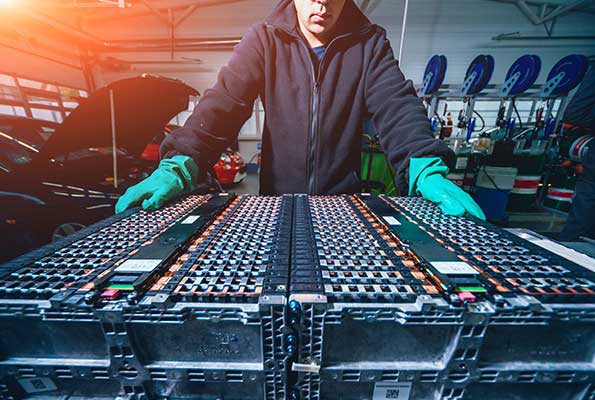The rapid adoption of electric vehicles (EVs) over the coming decades will lead to the availability of terawatt-hours of batteries that no longer fit the requirements for use in these vehicles. This is a lot of energy-storage potential when you consider that countries like the United States consume a few terawatts of electricity storage over an entire year.
Finding uses for these still usable batteries can add value significantly and ultimately help drive down storage costs to enable more integration of renewable energy into our grids.
Igniting A Second Life
Battery life for EVs is challenging. Lithium-ion batteries in EV applications degrade significantly within the first five years of operation and are often designed for a decade of useful life despite being exposed to severe operating temperatures, hundreds of partial cycles annually, and fluctuating discharge rates.
Even if they no longer fulfil the performance requirements for electric vehicles, which typically call for maintaining 80% of total usable capacity and attaining a resting self-discharge rate of only 5% over 24 hours, these batteries can nevertheless have a second life.
Such batteries can still function well enough to support less demanding applications, including stationary energy storage, after being remanufactured.
Manufacturers have three alternatives when an electric vehicle battery approaches the end of its useful initial life: they can discard it, recycle the valuable metals, or reuse it. Packs are most frequently disposed of if they are damaged or if they are located in areas without the requisite market infrastructure. Regulation generally prevents mass disposal. Given the anticipated shortage of nickel and maybe cobalt in the 2020s, recycling may make sense if the battery electrodes contain highly valuable metals like cobalt and nickel because there may be a sufficient difference between the cost of procurement and recycling.
Even though having a second source of battery metals through recycling can be attractive to battery manufacturers looking to secure their supply, it will be crucial to develop a recycling process that is sufficiently cost-competitive with mining for this path to gain scale. However, new processes that recover more material are still in their infancy.
The markets where there is a need for batteries for stationary energy-storage applications with less frequent battery cycling (for instance, 100 to 300 cycles per year) can benefit most from reuse.
According to cycling requirements, second-life electric vehicle batteries are best suited for three types of applications: supplying reserve energy capacity to maintain a utility’s power reliability at a lower cost by replacing more expensive and less efficient assets (such as old combined-cycle gas turbines), delaying transmission and distribution investments, and utilizing power-arbitrage opportunities by storing renewable energy for use during times of scarcity, thus providing In certain applications, second-hand batteries may cost 30 to 70% less1 in 2025 than new ones, tying up a lot less capital per cycle.
Large Quantities & Significant Difficulties
The second-life battery supply for stationary applications could surpass 200 gigawatt-hours per year by 2030 as a result of the current rapid growth of EVs and the even faster-predicted expansion over the following ten years in some scenarios.
This volume will be greater than the total demand for utility-scale lithium-ion storage for low- and high-cycle applications, which by 2030 will represent a market with a value north of USD 30 billion on a worldwide scale.
Several difficulties with reusing electric vehicle batteries must be overcome, nevertheless, to access this new source of battery supply.
The first is that there are several different battery-pack designs available on the market, each with a different size, electrode chemistry, and configuration (cylindrical, prismatic, or pouch).
The battery manufacturer and automobile OEM each design a battery to be best suited for a certain electric vehicle model, which increases refurbishing difficulty due to a lack of standardization and volume dispersion. By 2025, there could be up to 250 new electric vehicles with batteries from more than 15 producers.
The second issue is the decreasing cost of new batteries. Given that it is anticipated that the rate of fall in remanufacturing cost will lag the rate of decline in new manufacturing cost, the cost difference between new and used batteries will narrow as new batteries become more affordable.
The Final Verdict
We predict that, at the current rate of learning, the cost advantage that second-hand batteries are anticipated to show could now fall to about 25% by 2040. To justify the performance constraints of used batteries in comparison to new options, this cost differential must continue to be sufficiently wide.



